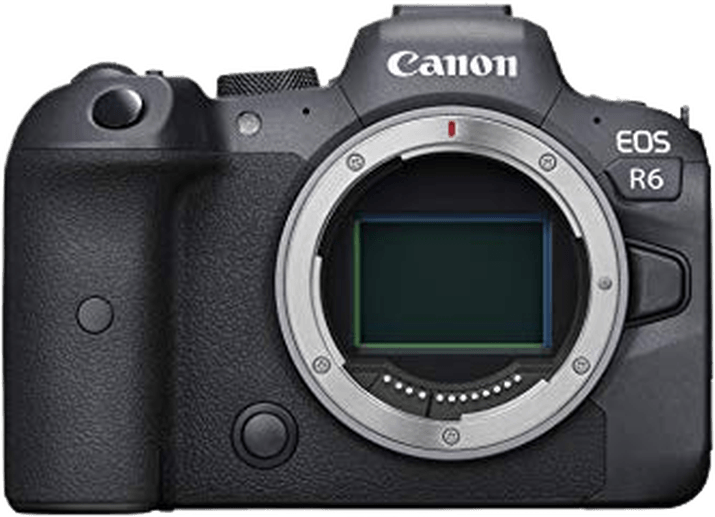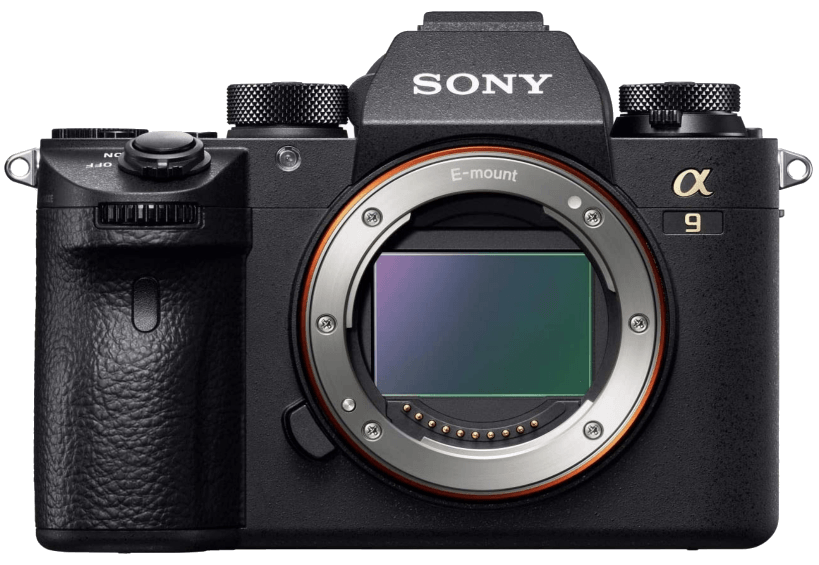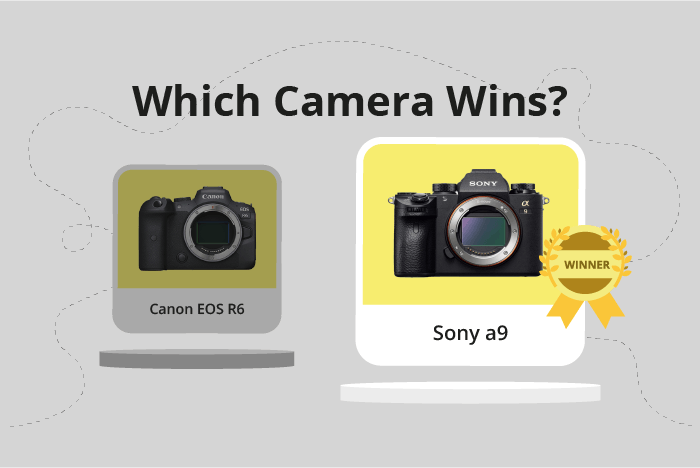Canon EOS R6 vs Sony a9 Comparison
Canon EOS R6

Sony a9

The Canon EOS R6 and Sony a9 both scored 80/100, making them equally competitive in our evaluation. As mirrorless cameras, they share several specifications, such as launch prices of $2499 for the Canon and $4500 for the Sony, and similar camera weights (Canon: 680g, Sony: 673g).
The Canon EOS R6 has an advantage with its more recent release year (2020) and larger camera size (138 x 98 x 88mm). This may provide improved features and a more ergonomic design. On the other hand, the Sony a9, released in 2017, is more compact (127 x 96 x 63mm), making it easier to carry and handle.
Taking these factors into account, the Canon EOS R6 offers a more updated option with a comfortable design, while the Sony a9 provides a lighter, more portable camera. Ultimately, the choice depends on the user’s preferences and priorities.
Canon EOS R6 vs Sony a9 Overview and Optics
The Sony a9 comes out on top in the optics comparison, scoring 81/100, while the Canon EOS R6 scores 79/100. Both cameras have several common specifications, such as a CMOS sensor, full-frame sensor size, 20 fps shooting speed, and in-body image stabilization. Additionally, they both utilize their respective company’s lens mounts – the Canon RF for the EOS R6 and the Sony FE for the a9.
The Sony a9 surpasses the Canon EOS R6 with its higher megapixel count of 24.2, compared to the R6’s 20.1 megapixels. This difference allows the a9 to capture more detailed images, making it a better choice for photographers who prioritize image resolution. Furthermore, the a9’s sensor has a higher DXOMARK score of 92, indicating better overall sensor performance compared to the R6’s score of 90.
On the other hand, the Canon EOS R6 features a more advanced Digic X processor, which can contribute to faster image processing and improved performance in certain shooting situations. This advantage, however, does not outweigh the benefits offered by the Sony a9’s superior optics.
In the optics comparison, the Sony a9 emerges as the winner, boasting a higher megapixel count and a better-performing sensor. Although the Canon EOS R6 has a more advanced processor, it falls short in terms of image resolution and sensor performance. Therefore, photographers seeking the best optics should opt for the Sony a9, while those who prioritize processing power may still find value in the Canon EOS R6.
Canon EOS R6 vs Sony a9 Video Performance
The Canon EOS R6 outperforms the Sony a9 in video capabilities with a significant difference in scores, as the Canon EOS R6 scores 91/100 and the Sony a9 scores 56/100. Both cameras share common specs, including a maximum video resolution of 4K and maximum video dimensions of 3840 x 2160. However, the Canon EOS R6 excels in specific areas, making it the superior choice for video functionality.
One notable advantage of the Canon EOS R6 is its maximum video frame rate of 120fps, which is four times higher than the Sony a9’s 30fps. This feature allows the Canon EOS R6 to capture smoother, more detailed slow-motion footage, providing more flexibility and creative options for videographers.
Additionally, the Canon EOS R6 offers built-in time-lapse functionality, whereas the Sony a9 lacks this feature. Time-lapse functionality enables the creation of dynamic, visually striking videos that showcase the passage of time, enhancing the storytelling capabilities of the camera.
On the other hand, the Sony a9 does not surpass the Canon EOS R6 in any specific video-related aspects. Both cameras share the same maximum video resolution and dimensions, but the Sony a9 falls short in frame rate and time-lapse functionality.
Taking these factors into account, the Canon EOS R6 is the clear winner in video capabilities due to its higher frame rate and built-in time-lapse functionality. The Sony a9, while still offering 4K resolution, does not provide the same level of versatility and creative options as the Canon EOS R6. Therefore, videographers seeking a camera with superior video performance should opt for the Canon EOS R6.
Canon EOS R6 vs Sony a9 Features and Benefits
The Canon EOS R6 outperforms the Sony a9 in features with a score of 85/100, compared to the Sony a9’s 83/100. Both cameras share several common specs, including a 3-inch screen size, touchscreen capabilities, flip screen, and the absence of GPS. Additionally, they both offer WIFI and Bluetooth connectivity.
The Canon EOS R6 surpasses the Sony a9 in screen resolution, providing 1,620,000 dots, whereas the Sony a9 has 1,440,000 dots. This difference in resolution results in a sharper and clearer display on the Canon EOS R6, making it easier to review and edit images directly on the camera.
While the Sony a9 has a slightly lower feature score, it still excels in certain aspects. The a9 offers a faster continuous shooting rate at 20 frames per second (fps), compared to the R6’s 12 fps. This advantage allows the Sony a9 to capture fast-moving subjects more effectively, making it an ideal choice for sports and wildlife photographers.
Each camera has its strengths and weaknesses, with the Canon EOS R6 taking the lead in overall features due to its superior screen resolution. However, the Sony a9’s faster continuous shooting rate should not be overlooked, especially for photographers who require speed in their work. Ultimately, the choice between these two cameras depends on the user’s specific needs and preferences.
Canon EOS R6 vs Sony a9 Storage and Battery
The Canon EOS R6 wins in storage and battery, scoring 68/100, while the Sony a9 scores 65/100. Both cameras have two memory card slots and accept SD, SDHC, and SDXC cards, with UHS-II compatibility.
The EOS R6 surpasses the a9 in terms of USB charging, offering this feature for added convenience. However, the a9 outperforms the EOS R6 in battery life, providing 650 shots compared to the R6’s 360 shots. The a9 utilizes the NP-FZ100 battery, while the R6 uses the LP-E6NH battery.
Considering these factors, the Canon EOS R6 is better for users who value USB charging, while the Sony a9 is more suitable for those seeking longer battery life.
Canon EOS R6 vs Sony a9 – Our Verdict
Are you still undecided about which camera is right for you? Have a look at these popular comparisons that feature the Canon EOS R6 or the Sony a9:

